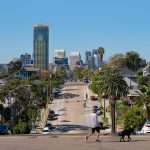What Does It Take to Get Local in San Diego?

San Diego is such a beautiful, fun, and friendly area that it’s one of the places in which many visitors daydream about what it would be like to live there.
But how many actually make the move? And what would you need to have to make it happen?
We’ll take a practical look at the upside as well as the downside of a move to “America’s Finest City,” especially in light of the recession risk of U.S. metros fueled by the coronavirus pandemic. We’ll run down the major factors to consider if opting for all that sunshine and all those beaches, from job opportunities to home prices to car insurance.
Who’s Moving to San Diego
If you’re a millennial, you’ll find lots of newcomer peers. That’s the generation flocking to San Diego. According to JLL, nearly one-third of San Diegans are millennials. That makes San Diego No. 2 only behind Austin, Texas, of cities with the most millennial residents.
With San Diego County having more military bases within its borders than any other city in the U.S., as well as hosting the largest naval fleet in the world, there is also a large contingent of military personnel and their families. And when active duty service members transition out of service, more than half of them prefer to stay in San Diego.
Pros & Cons of San Diego Living
Let’s look at why young people and veterans are choosing San Diego, as well as the challenges they have to learn to live with.
Pros of Living in San Diego
Weather: San Diego dubs itself as the most pleasant place on Earth, thanks to being a textbook example of perfect weather as well as getting the official ranking from the National Oceanic and Atmospheric Administration based on their raw data of 261 pleasant days a year, an average temperature of 55 to 75 degrees, and no significant rain or snow. It’s virtually an outdoor playground year-round.
Lifestyle: Even though San Diego is California’s second-largest city and America’s eighth-largest city, living where most people vacation and in such a temperate climate makes for a laid-back vibe – lots of yoga, lots of biking, and casual wear everywhere.
Culture: There is no reason you should ever have a dull moment in San Diego. When you need a break from the beaches, there’s the renowned San Diego Zoo, as well as Balboa Park, SeaWorld San Diego, and Legoland California, which offer discounts to residents.
There’s also a rich Mexican culture, including world-class Mexican food, thanks to being just a few freeway exits away from Baja California, Mexico.
San Diego is also home to one of the best craft beer industries in the nation.
When it comes to culture, San Diego’s list of opportunities seems as expansive as its beaches.
Schools: San Diego County has some of the best public schools in California, as five of their school districts are ranked in the top 10. And there are 12 four-year colleges within San Diego city limits.
Coastal City Affordability: If you want to be where the action is by living in the biggest cities in California, then San Diego is your best bet. It’s one of the top four, but it has a cheaper cost of living than the others – San Francisco (37.9% less), San Jose (25.4% less), and Los Angeles (8.2% less).
Safety: San Diego is safer than 32% of the cities in the U.S. Its crime rates are 10% lower than the national average, including violent crimes being 5% lower. And year over year, crime in San Diego has decreased by 2%.
Cons of Living in San Diego
Cost: Woody Guthrie’s Dust Bowl-era ballad still rings true nearly a century later.
“California is a garden of Eden, a paradise to live in or see;
But believe it or not, you won’t find it so hot
If you ain’t got the do re mi.”
While more affordable than California’s other biggest cities, it’s still a coastal city, which means it’s still pricey. That’s part of the reason why it ranks as No. 9 on the list of U.S. metro areas most at risk for a recession.
The San Diego-Carlsbad-San Marcos region has an unemployment rate of 15%, an average income of $61,386, an average credit card debt of $6,825, and a cost of living index of 160.1 (with the mean being 100).
That’s why a successful move to San Diego involves having the “do-re-mi”, such as a savings fund for the next possible emergency.
Traffic: The downside to living in paradise is having to deal with a large number of tourists, which creates a large amount of traffic no matter where you live and drive daily. While traffic isn’t as bad as places like L.A., it’s still going to take you much longer than it should to get anywhere. I-5 gets backed up fairly quickly, and there’s a lot of congestion when you go through town.
Traffic is even more challenging when there’s a major event in town, which happens quite frequently in San Diego – including Comic-Con, which has grown into the largest and most popular entertainment convention in the country.
And you will need a car, as, outside of downtown, San Diego is widespread and its public transportation isn’t on par with other major metropolitan cities. Cars mean smog checks, too.
Sports: Despite the perfect weather, you might not find San Diego so perfect if you’re a pro sports fan. While there’s plenty to see as far as collegiate athletics, the San Diego Padres are the only major sports team in town.
The Costs of Living in San Diego
If those pros outweigh those cons for you, let’s look at some specifics.
San Diego Job Market
San Diego has a healthier job market than similarly sized metro areas. Its economy primarily revolves around the military, tourism, research and manufacturing, and biotechnology.
The average salary in San Diego is $78,000. The most popular occupations are software engineer, project manager, and mechanical engineer. And the most popular employers are Northrop Grumman Corporation, Qualcomm Inc., and General Atomics Aeronautical Systems, Inc.
You’ll want to look into San Diego if you’re in the startup tech business but you can’t deal with the exorbitant cost of living in Silicon Valley. There’s a burgeoning biotech startup community in the San Diego area, which is one reason so many millennials are moving in.
San Diego Real Estate
The average home price in San Diego is $634,000. Like most of the country, tight inventory is keeping prices high and rising
The average rent? That’s $1,820 for a one-bedroom apartment. It’s the ninth most expensive city for renters.
This is another reason that you need a car. Unless you are making much more than the median salary, you’ll have to commute to areas outside of downtown to afford to live comfortably. The most affordable suburbs to look into include Lemon Grove, National City, Santee, Imperial Beach, and Poway. Additionally, a property management company can help you find an apartment within your budget while avoiding Craigslist scams.
San Diego Insurance
Car Insurance: Luckily, you have two factors working in your favor when it comes to getting car insurance in San Diego.
California is one of the few states that prohibit insurance companies from adjusting rates based on a person’s gender or credit score. These laws can save you a lot of money.
Expect to spend $1,773 on average for car insurance for living in San Diego. While that’s less than the statewide average in California, which is $1,868, it’s more than the national average of $1,548.
The most affordable car insurance companies for San Diegans are Geico, Progressive, and USAA.
Home Insurance: Thanks to the moderate weather, San Diegans can catch a break on their home insurance. The average rate is $905 a year. That’s lower than the statewide average of $974 and the national average of $1,083.
It’s helpful that home insurance is lower-than-average, as you’ll most likely want to look into riders for natural disasters depending on what part of the San Diego area you’re living, including add-ons for coverage for earthquakes, mudslides, flooding, and fires
When you are comparing prices, coverages, and discounts for your home insurance, start with the top-rated insurers in the San Diego area, which are Allstate, Amica, Farmers, and Lemonade.
Renters Insurance: The average cost of renters insurance in San Diego is $175 a year, or only $15 a month. This type of insurance is also lower than the statewide average, which is $220 a month.
You may also want to look into additional insurance to cover the risk of damage to your belongings from a natural disaster.
Your search for the best renters insurance company in San Diego should include reviewing the top-rated American Family, Lemonade, State Farm, and USAA.
We hope we’ve helped you make your decision easier about whether San Diego is the perfect place for your next move.
About the author: Karen Condor is an insurance expert who writes and researches for the insurance comparison site, ExpertInsuranceReviews.com. She and her husband fell in love with the San Diego area and started researching what it would take to live there before eventually moving to Massachusetts.






